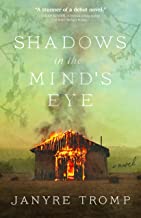| View this email in your browser |
 For review copy and interview information, contact: For review copy and interview information, contact:ajenningspr@gmail.com or 903-874-8363. |
| May is Mental Health Awareness Month 5 Tips for De-escalating Anxiety Attacks by Janyre Tromp The other day I grabbed the isopropyl alcohol to remove a sticker from a glass. I’ve done this a million times. But this time I opened the bottle, and my body immediately responded with shaking hands, a tight chest, narrowed vision, and the clear message to get the heck out of dodge. I was in a full-on, unexpected panic attack. While I was safe at home, my subconscious smelled the hospital, the pain, and fear that came with nearly losing my daughter and screamed that danger was nearby. It had been years since those horrendous times, but my body still respond to the memory of holding my daughter down . . . again . . . while nurses attempted another blood draw, another IV insertion, another poke. Can you relate? Sudden panic attacks can be debilitating, scary, and completely disorienting. Of course, there’s nothing that can replace a good therapist, distance, and possibly meds. The good news is that there are amazing tools we can use to help. Right now. Today. 4-7-8 Breathing.Growing up my mom was forever telling me to take a deep breath. Back then I thought it was just something moms said to distract their offspring. But it turns out that deep, diaphragmatic breathing is scientifically proven to release calming endorphins. It basically tells your brain that everything is cool. 4-7-8 breathing is known as a natural tranquilizer for the brain. Breathe in through your nose for four seconds, hold it for seven, and breathe out of your mouth for eight seconds. And then repeat it 3-4 times. It’s almost magic . . . almost. Sensory Countdown This technique is awesome when you feel a panic attack coming. It helps ground you in the safety of the present when your subconscious mind is trying to send you into flight or fight. Count five things you can see, four things you can touch, three things you can hear, two things you can smell, and one thing you can taste. As you practice this one, don’t worry if your mind drifts a little, just gently bring your attention back to the task and finish. Walking Not only does walking stimulate those feel-good endorphins, but it also was the basis for the creation of one of the most effective modern techniques to help anxiety and PTSD—EMDR (Eye movement desensitization and reprocessing). Hang in there with me for a second while I blow your mind just a little. EMDR involves revisiting painful memories at a mental distance while using bilateral stimulation (stimulating one side of the body and then the other and back again) to help the sufferer in and out of the memory. As we walk—alternating between our left and right feet—we are, in essence, performing bilateral stimulation, the basis of EMDR. Comforting sounds Whether it’s listening to a soothing song or ocean sounds, music and comforting sounds reduce the stress hormone cortisol. I use the song “Oceanic Feeling” from the album Brainspotting: BioLateral Sound Healing. Visualize a safe place This is a dreamy spot where you can let your mind drift. Typically, you don’t want to use a real place as reality has baggage. This is a place where you can relax, be yourself, and keep clean without having to haul out a vacuum. Mine is a cottage on a sand dune filled with sea glass and wind chimes. I can hear the surf rolling and the sea gulls calling. I can even smell the warmth of the sunshine on the sand, feel the sharp edges of dune grass on my fingers. Close your eyes. Imagine a place you would love to be. Maybe it’s chateau on top of a mountain, a cabin in the woods, a condo in the desert. Wherever it is. It’s safe, calm, and you have complete access and control. It’s a place where you can temporarily retreat to let your conscious, more logical mind catch up with your automatic responses. The more you practice the tools the more effective they are. So when you are safe and your subconscious knows you’re safe, visualize a cabin in the woods or a condo by the beach, breathe deeply in your bed before you sleep. Listen to the comforting sound while you walk. Then use the tools in irritating, but not panic inducing places—a traffic jam, when your kid leaves their shoes out and you trip over them on the way into the house. Then when you’re caught unaware like I was, the tools become almost automatic. For me I set down the container of alcohol, sat on the ground and performed the 4-7-8 breathing and sensory counting until I was anchored enough to realize what had happened, reassure myself that I was safe, and move on to removing the sticker. About the Author  Janyre Tromp (pronounced Jan-ear) is a historical suspense novelist who loves spinning tales that, at their core, hunt for beauty, even when it isn’t pretty. She’s the author of Shadows in the Mind’s Eye and coauthor of It’s a Wonderful Christmas.A firm believer in the power of an entertaining story, Tromp is also a book editor and published children’s book author. She lives in Grand Rapids, Michigan with her husband, two kids, two crazy cats, and a slightly eccentric Shetland Sheepdog.You can find her on Facebook (@JanyreTromp), Instagram (@JaynreTromp), Twitter (@JanyreTromp), and her website, www.JanyreTromp.com where you can download a free copy of her novella, Wide Open. About Shadows in the Mind’s Eye Janyre Tromp (pronounced Jan-ear) is a historical suspense novelist who loves spinning tales that, at their core, hunt for beauty, even when it isn’t pretty. She’s the author of Shadows in the Mind’s Eye and coauthor of It’s a Wonderful Christmas.A firm believer in the power of an entertaining story, Tromp is also a book editor and published children’s book author. She lives in Grand Rapids, Michigan with her husband, two kids, two crazy cats, and a slightly eccentric Shetland Sheepdog.You can find her on Facebook (@JanyreTromp), Instagram (@JaynreTromp), Twitter (@JanyreTromp), and her website, www.JanyreTromp.com where you can download a free copy of her novella, Wide Open. About Shadows in the Mind’s Eye  “Tromp weaves a complex historical tale incorporating love, suspense, hurt, and healing—all the elements that keep the pages turning.” “Tromp weaves a complex historical tale incorporating love, suspense, hurt, and healing—all the elements that keep the pages turning.”~ Julie Cantrell, New York Times and USA TODAY bestselling author of Perennials Charlotte Anne Mattas longs to turn back the clock. Before her husband, Sam, went to serve his country in the war, he was the man everyone could rely on—responsible, intelligent, and loving. But the person who’s come back to their family farm is very different from the protector Annie remembers. Sam’s experience in the Pacific theater has left him broken in ways no one can understand—but that everyone is learning to fear. Tongues start wagging after Sam nearly kills his own brother. Now when he claims to have seen men on the mountain when no one else has seen them, Annie isn’t the only one questioning his sanity and her safety. If there were criminals haunting the hills, there should be evidence beyond his claims. Is he really seeing what he says, or is his war-tortured mind conjuring ghosts? Annie desperately wants to believe her husband. But between his irrational choices and his nightmares leaking into the daytime, she’s terrified he’s going mad. Can she trust God to heal Sam’s mental wounds—or will sticking by him mean keeping her marriage at the cost of her own life? Debut novelist Janyre Tromp delivers a deliciously eerie, Hitchcockian story filled with love and suspense. Readers of psychological thrillers and historical fiction by Jaime Jo Wright and Sarah Sundin will add Tromp to their favorite authors list. (Kregel Publications/April 19, 2022/ISBN: 9780825447396/$15.99) |
-
Sexual Content - 0/5
0/5
-
Violence - 0/5
0/5
-
Language - 0/5
0/5
-
Drugs and Alcohol - 0/5
0/5

